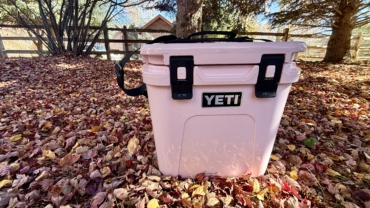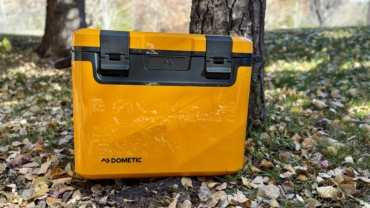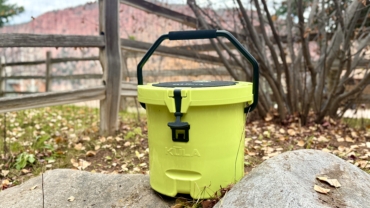If you enjoy outdoor recreation of any kind, getting caught in the rain at some point is inevitable. Here’s how to deal with it.
Being prepared before you go, having quality equipment, and knowing how to protect yourself when rain does come can make camping in it just another day on the trail.
While we may have a few good stories of “miserable” nights spent camping in a wet sleeping bag, in some climates, wet gear can be more of a hazard than just an inconvenience. Here’s how you can set yourself up to weather the storm when precipitation rolls in.
Tips for Camping in the Rain
1. Plan for Rain
The first part of camping in the rain is to assume it’s going to happen. Before you even start packing, check the weather forecast, no matter the length of the trip. Knowing what the weather might do can be highly advantageous for preparing physically and mentally to camp in the rain.
2. Gear Prep
The outdoor industry loves GORE-TEX — and for good reason. It sheds water efficiently while allowing for flexible movement and breathability. If GORE-TEX materials are taken care of by washing and treating them with Nikwax, they will stay waterproof in harsh environments.
The same goes for tents, tarps, backpacks, and other gear. Check tents and tarps for pinholes and patch them before waterproofing. Even the most expensive gear needs to receive care and maintenance if it’s going to last. If staying dry is a priority, care for the gear that will help you do that.

3. Choose the Right Materials
Always, always, always choose synthetic materials over cotton if you plan to be wet. Polyester, fleece, and wool can also provide warmth even when wet. Cotton, by contrast, will soak up water and lose all ability to keep you warm.
The same applies to down material. If there’s rain in the forecast, a synthetic sleeping bag is a better choice than down because it insulates even when wet.
4. Clothing Layers
Whenever hiking and camping in the rain, layer your clothes. The outer layer will always be a waterproof shell jacket and rain pants. Then you should have an insulating layer and a base layer underneath that.
Remember that temperatures will drop when a rainstorm rolls in and as night grows closer. Layers give you a higher chance of having some dry clothes and allow you to better adapt to changing weather conditions.

5. Bring Waterproof Bags
If you live and camp in a wet climate, black contractor trash bags will become your new best friend. Bringing along one that can line the inside of a larger pack and keep everything dry. You can also put it over the outside of the pack overnight to avoid a wet bag in the morning.
If you prefer a little more style and color coordination, you can also invest in a backpack rain cover.
Ziploc and other, more expensive brands offer a lot of fantastic waterproof bags. The smaller quart bags are great for phones and wallets, and gallon bags will keep a book bone dry for nighttime in the tent. And don’t forget about dry bags]. Small waterproof bags help keep your gear organized and ensure everything is dry.
6. Give Love to Your Feet
When camping and hiking, your feet are your life source. They can also easily get destroyed when rain hits.
To avoid trench foot and puddled up boots, research good waterproof boots beforehand and consider gaiters as an extra precaution.
Don’t forget to pack some extra socks and keep these handy to have happy feet all trip long.

7. Pick a Good Tent Site
When camping in the rain, choosing the right tent site can make or break the entire night of sleep. Tents should be positioned on a high point, avoiding places that could flood. Hard, compact soil will let water roll away rather than saturating quickly.
Pay attention to the surroundings as well. When it rains hard, the soil is softer, and trees will fall far more frequently and with less provocation than on a still, dry night. Find a spot away from hillsides full of trees and avoid dead trees to forgo getting caught in a mudslide or branches falling in the night.
8. Pack Tarps
Put a tarp both underneath your tent and even lining the inside of the tent. This essentially bombproofs the tent and keep every sleep system dry if the tent is positioned well. Construction tarps work just as well as nylon ones if there is space for them and will save you about $100.
A giant tarp can also act as a great communal area for cooking and spending time with friends at night. Setting up a shared shelter prevents everyone from retreating into their tents without coming out unless necessary.
A communal shelter can also be a great space to dry out any wet gear and clothing around the fire before the next day’s hike.

9. How to Collect Firewood
Now that there’s a great communal area, setting a fire for everyone will make the night even more enjoyable. If it has been raining for a long time, most wood on the ground may be rotten and full of water.
When car camping, having a load of wood in the car is a great solution, but it gets a little more complicated in the backcountry. When looking for firewood in the backcountry, look up. Branches often fall from trees and get stuck in others. Wood on the ground soaks up moisture from the ground. The deadwood stuck in trees will have a much lower moisture content.
10. If You Get Wet
Don’t worry. Everything will be OK. Remember that there are extra layers in your pack, your dry synthetic bag is waiting in the tent, and the fire under a group tarp will help dry everything out and get rid of the chill.
Camping in the Rain: Conclusion
These tips for camping in the rain can make it just as enjoyable as a clear moonlit night. It takes a bit more prep, but the payoff comes with the smell of soil through the air, streams flowing high, the sound of rain off the top of your tent, and not having to reschedule an adventure.









